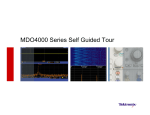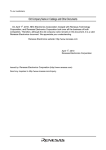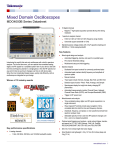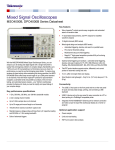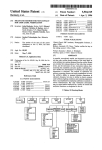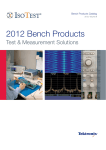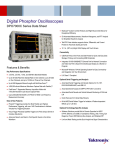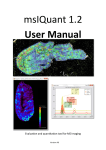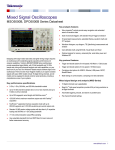Download Tektronix MDO Series Tour
Transcript
MDO4000B Series Self Guided Tour MDO4000B Mixed Domain Oscilloscope Self Guided Tour With this guide, you will explore what you can do with the world’s first oscilloscope with an integrated spectrum analyzer. Applications range from simple frequency / amplitude measurements of RF signals to time-correlated acquisitions of analog, digital and RF signals that provide you with a complete system view of your device under test. Application What You Will Experience Basic Spectrum Analysis Configuring the MDO4000B to look at the spectrum of interest and making basic spectral measurements 6 Spectral Peak Identification Quick and easy spectral peak identification via the MDO4000B’s automatic and manual markers 7 Viewing RF Signals Over Time Visualize slowly changing RF phenomena using Spectrograms 9 Viewing Complete System Activity Discover the MDO4000B’s unique ability to acquire and show time correlated analog, digital and RF signals in a single view 11 Debugging Amplitude Modulated Signals View how the amplitude of an Amplitude Shift Key (ASK) modulated signal changes over time 13 Debugging Frequency Modulated Signals Quickly visualize transient behavior of a frequency hopping signal 15 Capturing Wideband Signals Capture and analyze both 900 MHz and 2.4 GHz signals in a single acquisition 17 -1- Page MDO4000B Mixed Domain Oscilloscope Tour of the World’s First Mixed Domain Oscilloscope Traditional Front Panel Oscilloscope Controls Traditional Time Domain Display Dedicated Spectral Analysis Controls Frequency Domain Display Spectrum Analyzer Input (N-Type Connector ) -2- MDO4000B Mixed Domain Oscilloscope How It Works The Mixed Domain Oscilloscope The MDO4000B is the world’s first oscilloscope with an integrated spectrum analyzer. When the spectrum analyzer is off, the MDO works just like a traditional oscilloscope. When only the spectrum analyzer is on, the MDO works like a traditional spectrum analyzer. When both are on, you have the ultimate debug tool – the only instrument in the world capable of providing time correlated views of analog, digital and RF signals all in a single instrument. Digital Analog RF Time and Frequency Domains The real power of the MDO4000B comes from its universal trigger and acquisition system. All channels are fully integrated, so you can trigger on any of your signals and the oscilloscope will capture all channels simultaneously. As a result, all signals—analog, digital and RF—are time-correlated for accurate analysis. Since the MDO4000B captures a long time period of your RF signal, you can choose the precise spectrum you want to see at any point in time. By simply moving Spectrum Time through your acquisition, you can see how your RF spectrum is changing over time or device state. -3- MDO4000B Mixed Domain Oscilloscope Checklist for the Tour Before beginning the tour, please be sure you have the following items: MDO4000B Mixed Domain Oscilloscope Power cord Two (2) TPP1000 or TPP0500/B passive probes with hook tips attached Hook tip MDO Demo 1 board P6616 digital probe with extension ground tips connected to D0, D1 and D2 Extension ground tips can be found in the Logic Probe Accessories Kit USB cable BNC cable N-to-BNC adapter -4- O4000B Mixed Domain Oscilloscope g up for the Tour any test, one of the first steps is to connect the instrument to the device under test. For the initial exploration, a test s been provided to output signals needed for the tour. After you’ve completed the tour and have gained an nding of how the MDO4000B operates, please feel free to connect to your own system and see how the MDO can our day-to-day work. Setup the Oscilloscope and the Test Board and power on the oscilloscope. the (2) male B connectors of the able into the (2) USB host ports rear panel of the oscilloscope. the (1) male A connector of the able into the USB device port test board. The board is on he LEDs are lit. 2 Attach Probes to the Scope Connect TPP1000 or TPP0500/B passive probes to Channel 1 and Channel 2 inputs on the oscilloscope. Connect the P6616 digital probe to the D15-D0 input on the oscilloscope. Connect BNC cable here Connect digital probe D0, D1, and D2 here Connect passive probe tips here 3 Connecting the Probes to Test Board Connect Channel 1 probe tip to VCO1 Enable loop, connect Channel 2 probe tip to PLL-1 loop and both probe grounds to GND on the test board. Connect Digital probe: D0 to SPI_CLK, D1 to SPI_SS-1, D2 to SPI_MOSI square pins on the test board. Connect the N-to-BNC adapter to the RF input on the oscilloscope. Connect the BNC cable to the N-toBNC adapter. Connect the other end of the cable to the RF Out BNC connector on the test board. O4000B Mixed Domain Oscilloscope Spectrum Analysis DO4000B is the world’s first oscilloscope with an integrated spectrum analyzer. When the need arises to view RF it is far simpler and faster to continue using your tool of choice – the oscilloscope – rather than finding and ng a spectrum analyzer. ve: See how simple it is to perform basic spectrum analysis on an MDO4000B Setting Up the Mode button on the test until the CW LED is lit. the Default Setup front-panel n. the Ch1 front-panel button twice n off Ch1 RF front-panel button to turn on pectrum analyzer 2 Spectrum Analyzer Controls Notice an entire section of the front panel is dedicated to spectrum analyzer controls – no buried menus! Most commonly performed functions have front panel keys associated with them Setting center frequency/span Setting reference level Setting resolution bandwidth Using markers 10 digit keypad on front panel for precision entry of specific values 3 Basic Settings Press Freq/Span button Press Center Frequency (CF) bezel button Use keypad to set CF to 2.4 GHz Press Span bezel button Use Multipurpose b to set span to 10 MHz Press Ampl button Use Multipurpose a to set Reference Level to -10dBm Notice spectral peak is automatically marked Summary dition of a true RF acquisition system, N-connector, dedicated spectrum analyzer controls and user interface make O4000B Series the world’s first oscilloscope with an integrated spectrum analyzer. Now you can continue to use O4000B Mixed Domain Oscilloscope al Peak Identification ng peaks in your spectrum is one of the first steps to understanding the behavior of your design. Whether you are he basic marker functions or analyzing noise density or phase noise, easy-to-use tools are critical for saving time. ve: Discover how the frequency and amplitude of peaks in the spectrum are quickly identified with automated peak s. Learn how manual markers can be used to measure non-peak portions of the spectrum. 2 Setting Up Exploring Use Multipurpose a to set number of Peak Markers to 11 Press Threshold and use Multipurpose b to set threshold to -70.0 dBm Notice that peaks meeting the criteria are indicated with Absolute Frequency and Amplitude Readouts Press Readout to select Delta Notice peak readouts are now relative to the Reference Marker Press Manual Markers Notice the Ref. Marker can now be moved anywhere via manual markers the Mode button on the test until the Multiple Peaks LED is the Default Setup front-panel n. the Utility front panel-button. Utility Page and select Demo Multipurpose a . Multiple Peaks. Recall Demo Setup. Markers front-panel button. Summary erforming spectrum analysis, markers are an invaluable tool for easily quantifying peaks in a spectrum. Simply hreshold and excursion values to automatically mark all peaks that meet your criteria. Or user manual markers to O4000B Series Automatic Markers Marker Options Peak Markers To Center Press to turn markers on or off. Use Multipurpose a to select maximum number of peak to be marked. When Manual Markers are off, then the Reference marker is placed on the highest amplitude peak. When Manual Markers are on, then the Reference Marker is attached to Multipurpose a control. Press to quickly set the Center Frequency to the frequency of the Reference Marker . Thresholds If you are only interested in marking peaks above a certain level, then set the marker threshold to that level. Excursion If spectrum is noisy and all markers are on nonessential peaks, then adjust the excursion value. The excursion value is how far a signal amplitude needs to fall between marked peaks to be considered another valid peak. Manual Markers Press to turn on two manual markers to use for measuring non-peak areas of the spectrum. Readouts Absolute: Readouts are absolute frequency and absolute amplitude. Delta: Readouts indicates each peak’s delta frequency and delta amplitude relative to the Reference Marker . Manual Markers have a third line of readout information – For multipurpose a marker, this indicates noise density – For multipurpose b marker, this indicates noise density when readout is set to absolute; when set to delta, it indicates phase noise DO4000B Series Manual Markers O4000B Mixed Domain Oscilloscope g RF Signals Over Time rogram is a view of relative amplitudes in a spectrum as seen over time. The spectrogram display provides an color map showing how your signal varies over time. You can even go back and compare previously acquired data. ve: See how a spectrogram can be used to monitor a slowly changing RF signal and view different spectrums within ctrogram. 2 Setting Up Exploring Allow spectrogram to accumulate until half of the spectrogram display area is filled. Press Run/Stop to stop acquiring. Press RF button. Press Spectrogram. Turn Multipurpose a to scroll through Spectrum Slices. Or, enter desired Slice using keypad (such as slice -55). the Mode button on the test until the Spectrogram LED is lit. the Default Setup front-panel n. the Utility front panel-button. Utility Page and select Demo Multipurpose a . Spectrogram. Recall Demo Setup. Menu Off front-panel button. Summary e spectrogram view you can view how your RF signal is changing over time. You can monitor only portions of the triggered) or look at a wider range of signals (free run). For many designs, spectrum analysis begins with signal MDO4000B Series Spectrogram ow Spectrograms are Generated rum Acquired the spectrum trace to indicate amplitude at each point Cold colors (blue, green) indicate lower amplitude Hot colors (red, yellow) indicate higher amplitude rum is flipped with the peaks pointing towards the viewer with west acquired spectrum added to the bottom of the stack MDO4000B Series Spectrogram Slice Oldest Slice O4000B Mixed Domain Oscilloscope g Complete System Activity ging modern wireless-enabled designs often requires investigation of more than just the RF signal. Understanding relationships between the RF and other analog, digital, or bus signals in the device under test is critical but incredibly t with multiple stand alone pieces of test equipment that weren’t designed for the task.. ive: Experience the MDO4000B’s unique ability to acquire and display time correlated analog, digital and RF signals. 2 Setting Up Exploring Press the Single front-panel button to arm the scope for an acquisition. Press the VCO-1 Enabled button on the demo board. The LED next to the button should turn off. Press the VCO-1 Enabled button again. The LED next to the button should light and the scope should acquire data. Use the front-panel Wave Inspector Pan knob (outer ring) to move the Spectrum Time indicator (orange bar) through the acquisition to see how the spectrum changes during the VCO/PLL turn on. that the oscilloscope and test are setup as previously directed. the Mode button on the test until the VCO/PLL-1 Turn On s lit. the Default Setup front-panel n. the Utility front panel-button. Utility Page and select Demo Multipurpose . VCO/PLL Turn On button. Recall Demo Setup. Menu Off front-panel button. Summary Mixed Domain Oscilloscope, you can easily track down system-level issues by viewing analog, digital and RF signals rrelated on the same display. By moving Spectrum Time throughout the waveform record, you can quickly see how nation of Spectrum Time trum shown in the frequency domain graticule corresponds to the period of time indicated by the orange bar in the time domain graticule ge bar is known as Spectrum Time. Time can be moved throughout the acquisition to see how the spectrum changes over time or relative to other analog, digital, or bus signals. s Happening? (voltage controlled oscillator) is enabled when channel 1 goes high. mmand on the SPI bus tells the VCO/PLL (phase-locked loop) circuit the desired frequency, which in this case is 2.4 GHz. SPI command has been transmitted, the VCO/PLL circuit begins tuning to the desired frequency. eenshots below, we’ve made a single acquisition of this turn-on event by triggering on the SPI command indicating the desired 2.4 GHz freq. shot 1, the Spectrum Time (orange bar) is positioned prior to the VCO being enabled, thus there is no activity in the spectrum yet. shot 2, the Spectrum Time (orange bar) has been moved (via the Wave Inspector Pan knob) to view the spectrum about midway through PLL’s process of tuning to the desired frequency. MDO4000B Series, you can easily correlate frequency domain events with relevant time domain control signals, enabling you to quickly and ke critical timing measurements such as time to stability of a VCO/PLL circuit. 1 Spectrum Prior to Trigger Event 2 Spectrum After the Trigger Event O4000B Mixed Domain Oscilloscope ging Amplitude Modulated Signals ng RF signal amplitude changes over time and monitoring system-level interactions of analog and RF signals can cult and time-consuming. Time trend views of amplitude vs. time can make spectrum analysis an easier task. ve: Discover how to quickly see the amplitude changes over time of an Amplitude Shift Key (ASK) modulated signal he MDO4000B’s RF Amplitude vs. Time trace. 2 Setting Up Exploring Press the Single front-panel button to acquire a single acquisition. Use the front-panel Wave Inspector Pan knob (outer ring) to move the Spectrum Time indicator (orange bar) through the acquisition to see how the spectrum changes with the ASK modulation. Notice the RF Amplitude vs. Time trace in the time domain graticule (orange) allows you to quickly see how the RF signal amplitude changes over time and relative to other time domain signals Channel 1 probe tip to the ASKloop, move Channel 2 probe tip to RIGGER loop on the test board. the Mode button on the test board he ASK Modulation LED is lit. the Default Setup front-panel n. the Utility front panel-button. Utility Page and select Demo Multipurpose . ASK Modulation button. Recall Demo Setup. Menu Off front-panel button. Summary Mixed Domain Oscilloscope, you can quickly investigate amplitude modulated RF signals. The RF amplitude vs. time hows the instantaneous amplitude of the acquired spectrum and can provide insight into such problems as noise, nation of Spectrum Time trum shown in the frequency domain graticule corresponds to the period of time indicated by the orange bar in the time domain graticule ge bar is known as Spectrum Time. Time can be moved throughout the acquisition to see how the spectrum changes over time or relative to other analog, digital, or bus signals. s Happening? (Amplitude Shift Key) Modulation signal on Channel 1 is a digital modulation control signal that is turning the RF output on and off in order to 3 bit counter progressing through the numbers 0-7. eference signal on Channel 2 is shown to aid in understanding the bit pattern on the modulation signal. f the screenshots, the position of Spectrum Time (orange bar) has been moved to view the spectrum at various points in time. In 1 Spectrum Time is positioned where the RF output has been on and stable for a while, thus the view in the frequency domain is a stable signal at 2.4 GHz. In 2 Spectrum Time is positioned at an off-to-on transition in the RF, thus we see ‘smearing’ in the frequency domain. Similarly, in 3 Spectrum Time is positioned at an on-to-off transition in the RF, thus we again see ‘smearing’ in the frequency domain. you can quickly see how the RF signal amplitude changes over time and relative to other analog or digital control signals. MDO4000B Series, you can easily correlate frequency domain events with changes in the time domain signals. 1 2 3 O4000B Mixed Domain Oscilloscope ging Frequency Modulated Signals terizing and correlating time varying RF events with analog signals can be difficult and time-consuming. With the cilloscope, you can easily monitor system behavior with easy-to-use signal visualization tools. ve: Explore how the RF Frequency vs. Time trace allows you to quickly characterize time varying events of a cy hopping signal (such as how long it takes to settle to a new frequency). Setting Up 2 Channel 1 probe tip to the GER loop on the test board. the Mode button on the test board he Frequency Hop LED is lit. the Default Setup front-panel n. the Utility front panel-button. Utility Page and select Demo Multipurpose . Frequency Hop button. Recall Demo Setup. Menu Off front-panel button. Press the Single front-panel button to acquire a single acquisition. Use the front-panel Wave Inspector Pan knob (outer ring) to move the Spectrum Time indicator (orange bar) through the acquisition to see how the spectrum changes with the Frequency Modulation. Notice the RF Frequency vs. Time trace in the time domain graticule (orange) allows you to quickly see how the RF signal frequency changes over time and relative to other time domain signals. Exploring Summary RF signals can vary significantly with time. With a Mixed Domain Oscilloscope, you can quickly characterize time RF events – without having to look through the spectrum in the frequency domain view. nation of Spectrum Time trum shown in the frequency domain graticule corresponds to the period of time indicated by the orange bar in the time domain graticule ge bar is known as Spectrum Time. Time can be moved throughout the acquisition to see how the spectrum changes over time or relative to other analog, digital, or bus signals. s Happening? er signal on Channel 1 is a digital control signal that initiates the frequency hopping cycle. f the screenshots, the position of the Spectrum Time (orange bar) has been moved to view the spectrum at various points in time after the nt. In 1 Spectrum Time is positioned in the middle of the second hop frequency, thus the frequency domain view shows a single peak at 2.4 GHz In 2 Spectrum Time is positioned in the transition from the 2nd hop frequency to the 3rd, thus we see RF energy smeared across the spectrum n the frequency domain view. In 3 Spectrum Time is positioned in the transition from the 3rd hop frequency back to the 1st. This is a wider transition, thus we see RF energy smeared across more of the spectrum in the frequency domain view. you can quickly characterize time varying RF events (such as how long it takes to settle to a new frequency or how much undershoot there is during a transition) with RF vs. time traces. MDO4000B Series, you can easily correlate frequency domain events with changes in the time domain signals. 1 2 3 O4000B Mixed Domain Oscilloscope ring Wideband Signals ndards continue to evolve to wider bandwidths. In addition, many modern wireless devices transmit and receive over bands. Traditional spectrum analyzers do not have the capture bandwidth necessary to debug these systems. ve: See the power of the MDO4000B’s exceptionally wide capture bandwidth (up to 3 GHz) by capturing an RF s transition from 900 MHz to 2.4 GHz in a single acquisition. 2 Setting Up e the Channel 1 probe tip is on RIGGER loop on the test board. the Mode button on the test until the Capture BW LED is lit. the Default Setup front-panel n. the Utility front panel-button. Utility Page and select Demo Multipurpose . Capture Bandwidth button. Recall Demo Setup. Menu Off front-panel button. Exploring Press the Single front-panel button to acquire a single acquisition. Notice the Span is set to 3 GHz. This is 3 GHz capture bandwidth. Use the front-panel Wave Inspector Pan knob (outer ring) to move the Spectrum Time indicator (orange bar) before and after the pulse on Ch 1 Notice that before the pulse, the RF output is at 900 MHz, it then transitions to 2.4 GHz after the pulse. Summary e MDO4000B Series, you can see your whole spectrum of interest at any point in time with the up to 3 GHz ultra-wide bandwidth (approximately 100 times wider than the 10-40 MHz capture bandwidths of traditional spectrum analyzers). nation of Spectrum Time trum shown in the frequency domain graticule corresponds to the period of time indicated by the orange bar in the time domain graticule ge bar is known as Spectrum Time. Time can be moved throughout the acquisition to see how the spectrum changes over time or relative to other analog, digital, or bus signals. s Happening? e see on channel 1 is a control signal telling the device to switch the RF output from 900 MHz to 2.4 GHz. apturing this transition in a single acquisition! This ability to look across 3 GHz of spectrum and correlate the RF activity to other analog and als is unique to the MDO4000B. shot 1, Spectrum Time is positioned prior to the trigger event (single pulse on channel 1). In the spectrum, the device under test is currently ating to a device in the 900 MHz ISM (Industrial, Scientific, and Medical) radio band. shot 2, Spectrum Time has been moved to view the spectrum after the trigger event. In the spectrum, the digital control signal (the trigger ults in the RF output switching from communicating from one device in the 900 MHz ISM radio band to another device in the 2.4 GHz ISM . at both the 900 MHz and 2.4 GHz ISM radios bands are captured in a single acquisition. A typical spectrum analyzer with capture bandwidth Hz could not capture this wideband, transitory event. MDO4000B Series , you can easily correlate frequency domain events with changes in the time domain signals. 1 Spectrum Prior to Trigger Event 2 Spectrum After the Trigger Event 4000B Series Mixed Domain Oscilloscopes ecifications and ordering information -3 -3 -3 -6 -3 -6 Analog Analog Analog Digital Ch. Bandwidth Sample Rate Ch. 4 4 4 4 4 4 100 MHz 350 MHz 500 MHz 500 MHz 1 GHz 1 GHz 2.5 GS/s 2.5 GS/s 2.5 GS/s 2.5 GS/s 5 GS/s 5 GS/s robes and Accessories 16 16 16 16 16 16 Digital Sample Rate Main / MagniVu™ RF Ch. RF Frequency Range 500 MS/s / 16.5 GS/s 500 MS/s / 16.5 GS/s 500 MS/s / 16.5 GS/s 500 MS/s / 16.5 GS/s 500 MS/s / 16.5 GS/s 500 MS/s / 16.5 GS/s 1 1 1 1 1 1 9 kHz – 3 GHz 9 kHz – 3 GHz 9 kHz – 3 GHz 9 kHz – 6 GHz 9 kHz – 3 GHz 9 kHz – 6 GHz 0500 (500 MHz models) or TPP1000 odels) Passive Voltage Probes 6 16 Channel Logic Probe Adapter (103-0045-00) ce® Desktop and Trial Version of SignalVuSignal Analysis Software n Certificate, Quick Reference Manual & ation on CD el Cover, Power Cord rranty RF Accessories TPP0502 500 MHz, 2X, 300V TekVPI Low C (12.7 pF) Modules Triggering and Protocol Analysis Aerospace (MIL-STD 1553) O Audio (I2S, LJ, RJ and TDM) Automotive (CAN, LIN) MA Automotive (CAN, LIN, FlexRay) Computer (RS-232/422/485) Embedded (I2C, SPI) Ethernet (10BASET,100BASE-TX) USB 2.0 (LS, FS, HS) TPP1000 1 GHz, 10X, 300V TekVPI Low C (3.9 pF) Analysis Adv. RF Power Level Triggering Power Analysis Limit and Mask Testing HDTV & Custom Video Key Applications Benefits System-level Troubleshooting of Wireless-enabled Designs (Zigbee, Bluetooth, WLAN) • See your time-correlated analog, digital and RF signals on a single display • Analyze the time and frequency domains with one instrument. • Monitor multiple points of your design at one time Hunting Noise Sources • Analyze your RF spectrum for noise with the built-in spectrum analyzer • Identify sources of noise with the time-correlated display of analog, digital and RF signals Spectral Analysis • Investigate your RF spectrum with the tools of a general-purpose spectrum analyzer • See your entire spectrum at once with a > 1 GHz capture bandwidth Recommended Probes and Accessories TPA-N-PRE Preamplifier, 12 dB gain, 9kHz – 6 GHz TPA-N-VPI N-to-TekVPI Adapter 119-4146-00 Near Field Probe Set, 100 kHz – 1 GHz 119-6609-00 Flexible Monopole Antenna Passive Voltage Probes TPP0500/B 500 MHz, 10X, 300V TekVPI Low C (3.9 pF) Active Voltage Probes TAP1500 1.5 GHz, 10X, ±8V TekVPI, Single-ended TAP2500 2.5 GHz, 10X, ±4V TekVPI, Single-ended TAP3500 3.5 GHz, 10X, ±4V TekVPI, Single-ended Differential Voltage Probes TDP0500 500 MHz, 50X/5X, ±42V TekVPI, Differential TDP1000 1 GHz, 50X/5X, ±42V TekVPI, Differential TDP1500 1.5 GHz, 10X/1X, ±8V TekVPI, Differential TDP3500 3.5 GHz, 5X, ±2V TekVPI, Differential THDP0100 100 MHz, 1000X/100X, ±6kV TekVPI, Diff. THDP0200 200 MHz, 500X/50X, ±1.5kV TekVPI, Diff. TMDP0200 200 MHz, 250X/25X, ±750V TekVPI, Diff. Current Probes TCP0020 50 MHz, 20A AC/DC TekVPI TCP0030 120 MHz, 30A AC/DC TekVPI TCP0150 20 MHz, 150A AC/DC TekVPI Service Options C3 C5 D1 R5 Calibration Service 3 Years Calibration Service 5 Years Calibration Data Report Repair Service 5 Years O4000B Mixed Domain Oscilloscope ary concludes the MDO tour. You have just experienced the world’s first oscilloscope an integrated spectrum analyzer. This enables you to continue to use your tool of ce – the oscilloscope – to debug your designs regardless of whether you’re tracking n time or frequency domain issues. In addition, the MDO4000B’s unique capability of uiring and displaying time correlated analog, digital, and RF in a single instrument es it the ultimate debug tool for the modern design engineer. Complete system ility like this hasn’t existed before now. you ready to try this on your own design? earn more, visit www.tektronix.com/mdo4000b for detailed application notes, videos other materials. For further product demonstrations or to request a quote, please act your local Tektronix authorized distributor.





















